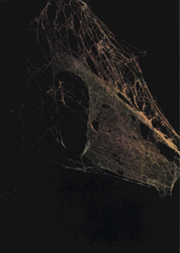AustLit
-
Artist
Artist: Sandra Selig
Birth date, place: Born, Seven Hills, New South Wales.
Currently lives & works in Brisbane, Queensland.
This artist's profile was developed by Jacques Langlasse during 2014 at The University of Queensland as a part of the Visual Arts Curating and Writing course, convened by Dr Allison Holland.
-
Sandra Selig is influenced or rather associates her practice strongly to artists such as Lygia Clarke, Gertrude Goldschmidt (Gego) and Jesus Raphael Soto. She has been increasingly interested in artists from this period (post 1960’s geometric abstraction in Latin America) because of the entropic use of geometric form in their work, which in different ways, strongly connects to the viewer’s unfolding, temporal experience of it and to the artists sometimes heroic pursuit of personal freedom and spirituality through abstraction in art. Selig collects images and information from sources traditionally outside of art history such as science and astrophysics; fields that also attempt to create patterns, which reflect intangible aspects of human existence in relation to the cosmos. To a further extent
Selig is influenced from the music that she creates for herself, and for sound installations. There is a strong connection between Selig’s music and artistic pursuit. For example one of the origins of Selig’s ongoing thread installations comes from wanting to make an object in space that approached the presence and intangibility of music. Living and working in Australia, Selig has been based mainly in suburban areas, working mostly from a domestic environment. In this way, her work reflects a personal world where everyday experiences are woven into concentrated periods of making and working with abstraction. In regards to the Universe series, it is easy to see what impact the domestic environment has on Selig’s art in terms of examining and making work from spider’s webs. The concept of intangibility and the pursuit of unveiling what cannot be seen by the human eye are central to Selig’s practice.
-
'Be some other material', 2011: Artspace, Sydney
http://www.artspace.org.au/gallery_project.php?i=150
'Contemporary Australia: Women’, ‘Prisms remember you', 2011-2012: GOMA, Brisbane
http://www.qagoma.qld.gov.au/exhibitions/past/2012/contemporary_australia_women/artists/sandra_selig
-
Graduating in Visual Arts and Honours in 1995, Sandra Selig has progressed to be one of Brisbane’s most renowned installation artists. Sandra works predominantly in installation and is best known for her linear thread installations, featuring at various exhibitions including and not limited to Circuit, 2006 at the Institute of Modern Art, Brisbane. Selig has featured in a substantial amount of solo exhibitions including; ‘Sleeping Rainbow Interleaves’, Sarah Cottier Gallery, Paddington, NSW, 2013; ‘Be Some Other Material’, Artspace, Sydney, 2011; ‘Waves Depend on Us (Light from Tokyo)’, Milani Gallery, Brisbane, 2009; ‘Invisible Surround’, Milani Gallery, Brisbane, 2008. Furthermore Selig has contributed in various selected group exhibitions, based predominately throughout Australia. These include most recently ‘Sonic Spheres,’ at the TarraWarra Biennial 2012 and at the 2010 Adelaide Biennial of Australian Art: Before and After Science at Art Gallery of South Australia, Adelaide.
Selig’s work does however stretch beyond the continent having been awarded two Artist in Residence Programs; The first; documented in 2004 at the International Artist in Residence Program, Guernsey College of Further Education, Art and Design, St Peter Port, Guersey, Great Britain. It is worth mentioning that at this time Selig’s work was exhibited in a solo exhibition which took place in Guernsey the same year. The latter; a three month Artist Residency, awarded in 2006 and undertaken in 2008, at the Australia Council Studio in Tokyo, Japan. Throughout her career, Selig has been concerned with the cosmos; in particular the representation of preserving something which is usually part of a quick (but familiar) existence - decay cycle. This concept is clearly developed from the early stages of her professional career dating back to Modulus, 2004 where Selig connects plastic drinking straws attached to the interior of the MCA, Sydney, creating a complex and intangible sculpture between the straws and the space they occupy. Selig’s work has evolved to a certain extent in regards to the medium she works with. In contrast to the early years of her artistic practice, Selig is driven more so now than ever before by her interest in music (Selig is currently playing music for band: Primitive Motion) in conjunction with her installations. This interest however is not reflective in her chosen medium at a group exhibition titled, ‘Group Show #27,’ currently on display at the Sarah Cottier Gallery from 1- 31 May, 2014.
-
The Universes (ongoing 2005-)
Spider silk, enamel, fixative on paper
A spider web can be a site-specific sculpture. Through human intervention, it is collapsible into a space thin enough to become a drawing on a piece of paper. Sometimes the drawings are alarming for their complexity and for their scale and also for the fact that they preserve something which is usually part of a quick (but familiar) existence - decay cycle. In making tangible that which may never have been seen, the drawings also represent that which will never be seen. Similarly, through human intervention distant galaxies can also be collapsible sculptures as their time-light can be condensed into the size of a photograph.
Sandra Selig
September 2007
You might be interested in...




